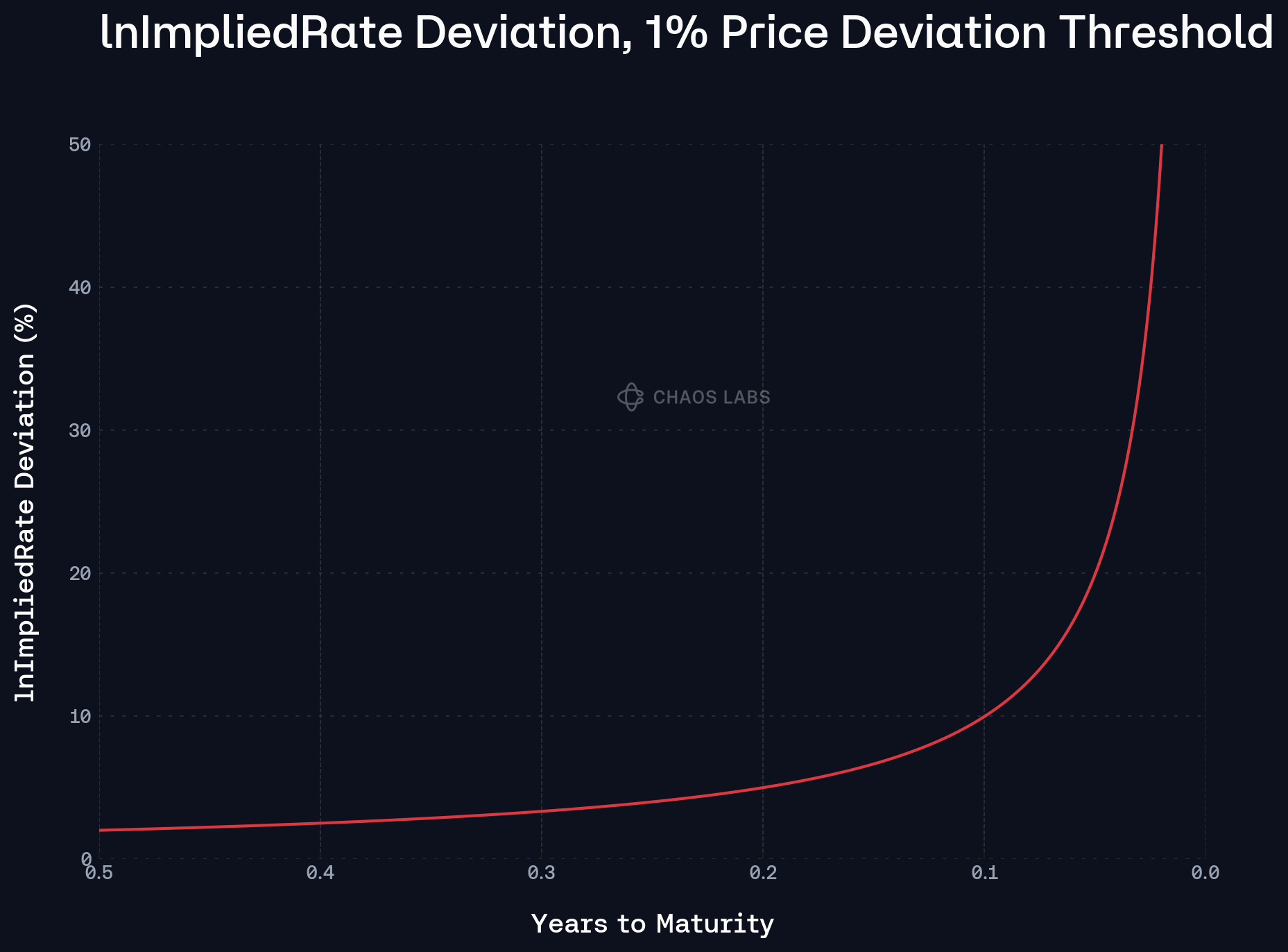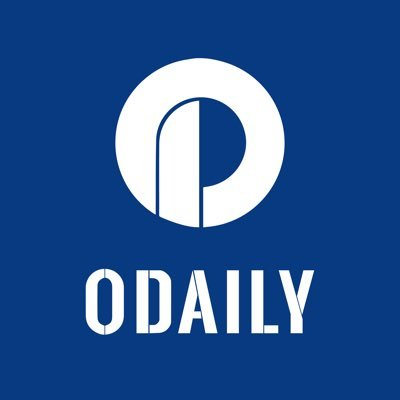Be wary of discount rate risk: the mechanism and risk of AAVE, Pendle, Ethena's PT leveraged return flywheel
Original author: @Web3_Mario
has been a little busy lately, so I have delayed the update for a while, and now I will resume the frequency of weekly updates, and thank you for your support. This week, we found that there is an interesting strategy in the DeFi space that has received a lot of attention and discussion, that is, using Ethena's staking yield certificate sUSDe and PT-sUSDe in Pendle as the source of income, and using the AAVE lending protocol as the source of funds to carry out interest rate arbitrage and obtain leveraged income. Some DeFi Kols on the X platform have made more optimistic comments about this strategy, but I think the current market seems to ignore some of the risks behind this strategy. Therefore, I have some experience to share with you. In general, AAVE+Pendle+Ethena's PT leveraged mining strategy is not a risk-free arbitrage strategy, in which the discount rate risk of PT assets still exists, so participating users need to objectively evaluate, control the leverage ratio, and avoid liquidation.
Friends
who are familiar with DeFi should know that DeFi, as a decentralized financial service, compared with TradFi, the core advantage is the so-called "interoperability" advantage brought by the use of smart contracts to carry core business capabilities, and most DeFi proficient people, or DeFi Degen's work usually has three:
1. Explore arbitrage opportunities between DeFi protocols;
2. Find sources of leveraged funds;
3. Explore high-interest rate and low-risk-return scenarios;
The PT leveraged income strategy reflects these three characteristics more comprehensively. The strategy involves three DeFi protocols, Ethena, Pendle, and AAVE. All three of them are popular projects in the current DeFi track, and they are just a brief introduction here. First of all, Ethena is a yield-based stablecoin protocol that captures short positions in the perpetual contract market on centralized exchanges with low risk through Delta Neutral's hedging strategy. In a bull market, the strategy has a higher yield due to the extremely strong demand for long positions by retail investors and their willingness to bear higher fee costs, with sUSDe being its income certificate. Pendle is a fixed-rate protocol that decomposes the floating yield certificate token into Principal Token (PT) and income certificate (YT) similar to zero-coupon bonds by synthesizing assets. AAVE, on the other hand, is a decentralized lending protocol that allows users to use specified cryptocurrencies as collateral and lend other cryptocurrencies from AAVE to increase leverage, hedge, or short.
This strategy is the integration of the three protocols, that is, using Ethena's staking income certificate sUSDe and the fixed income certificate PT-sUSDe in Pendle as the source of income, and using the AAVE lending protocol as the source of funds to carry out interest rate arbitrage and obtain leveraged income. The specific process is as follows, first, users can obtain sUSDe at Ethena and fully convert it to PT-sUSDe through the Pendle protocol to lock in the interest rate, and then deposit PT-sUSDe into AAVE as collateral, and lend USDe or other stablecoins through revolving loans, repeating the above strategy to increase capital leverage. The calculation of the return is mainly determined by three factors, the base yield of PT-sUSDe, the leverage multiplier, and the spread in AAVE.

the market status and user participation of this strategyThe
popularity of this strategy can be traced back to AAVE, as the largest lending protocol with the largest amount of funds, to recognize PT assets as collateral, which has released the financing ability of PT assets. In fact, other DeFi protocols have long supported PT assets as collateral, such as Morpho, Fuild, etc., but AAVE can provide lower borrowing rates with more available loans, amplifying the yield of this strategy, and AAVE's decision is more symbolic.
Therefore, since AAVE supported PT assets, the pledged funds have risen rapidly, which also shows that the strategy has been recognized by DeFi users, especially some whale users. Currently, AAVE supports two PT assets, PT sUSDe July and PT eUSDe
May, and the total supply has reached about $1 B.

The maximum leverage currently supported can be calculated based on the Max LTV of its E-Mode, taking PT sUSDe July as an example, the Max LTV of this asset as collateral in E-Mode mode is 88.9%, which means that with a revolving loan, the leverage ratio can theoretically be about 9x. The specific calculation process is shown in the figure below, that is to say, when the leverage is maximum, without considering the flash loan or capital exchange cost caused by gas and revolving loans, taking the sUSDe strategy as an example, the theoretical return rate of the strategy can come to 60.79%. And this yield does not include Ethena points rewards.
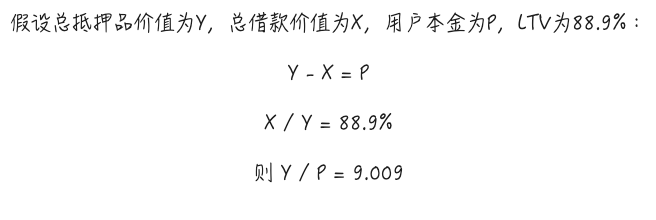
Let's take a look at the actual participant distribution, again taking the PT-sUSDe pool on AAVE as an example. With a total supply of 450 M provided by a total of 78 investors, it can be said that the proportion of whales is high, and the leverage is not small.
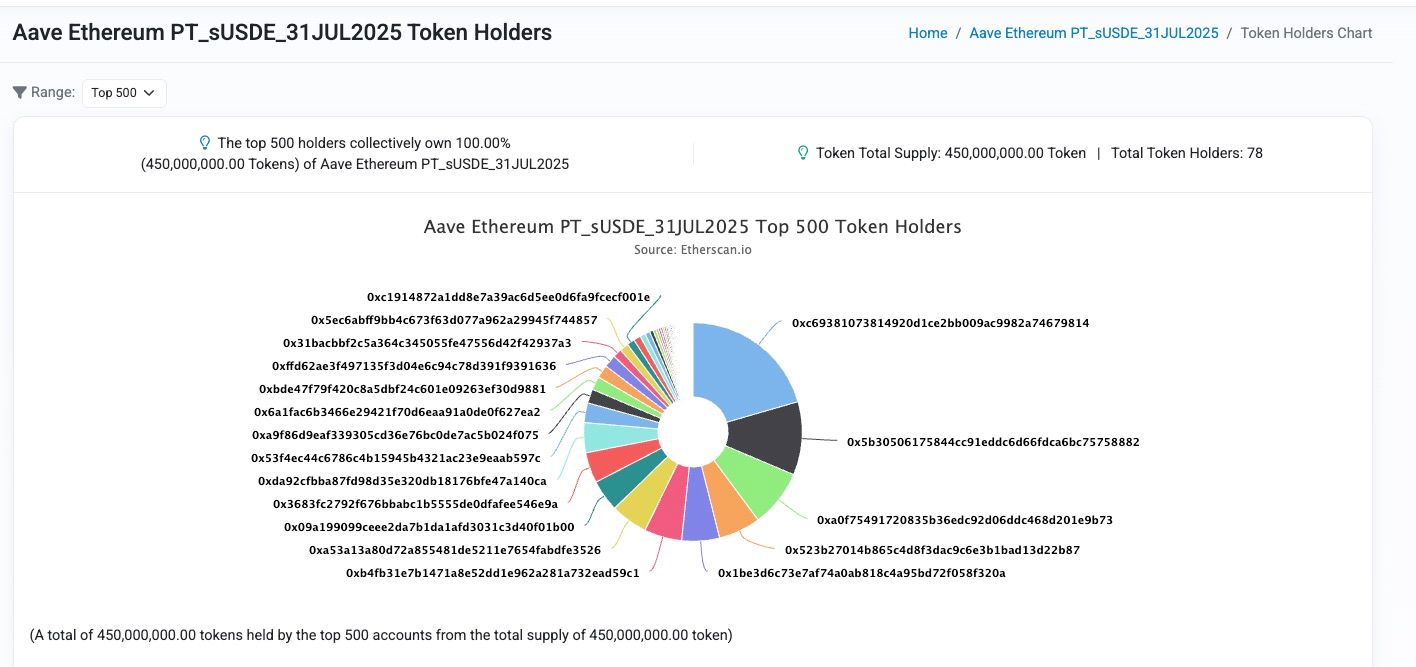
The 0x c 693...9814 account in the first place has a leverage of 9x and a principal of about 10 M. The 0x 5 b3 05...8882 account in the second place has a leverage of 6.6x and a principal of about 7.25 M, the third place analytico.eth has a leverage of 6.5x and a principal of about 5.75 M, and the 0x 523 b 27...2b 87 account in the fourth place has a leverage of 8.35x and a principal of about 3.29 M.
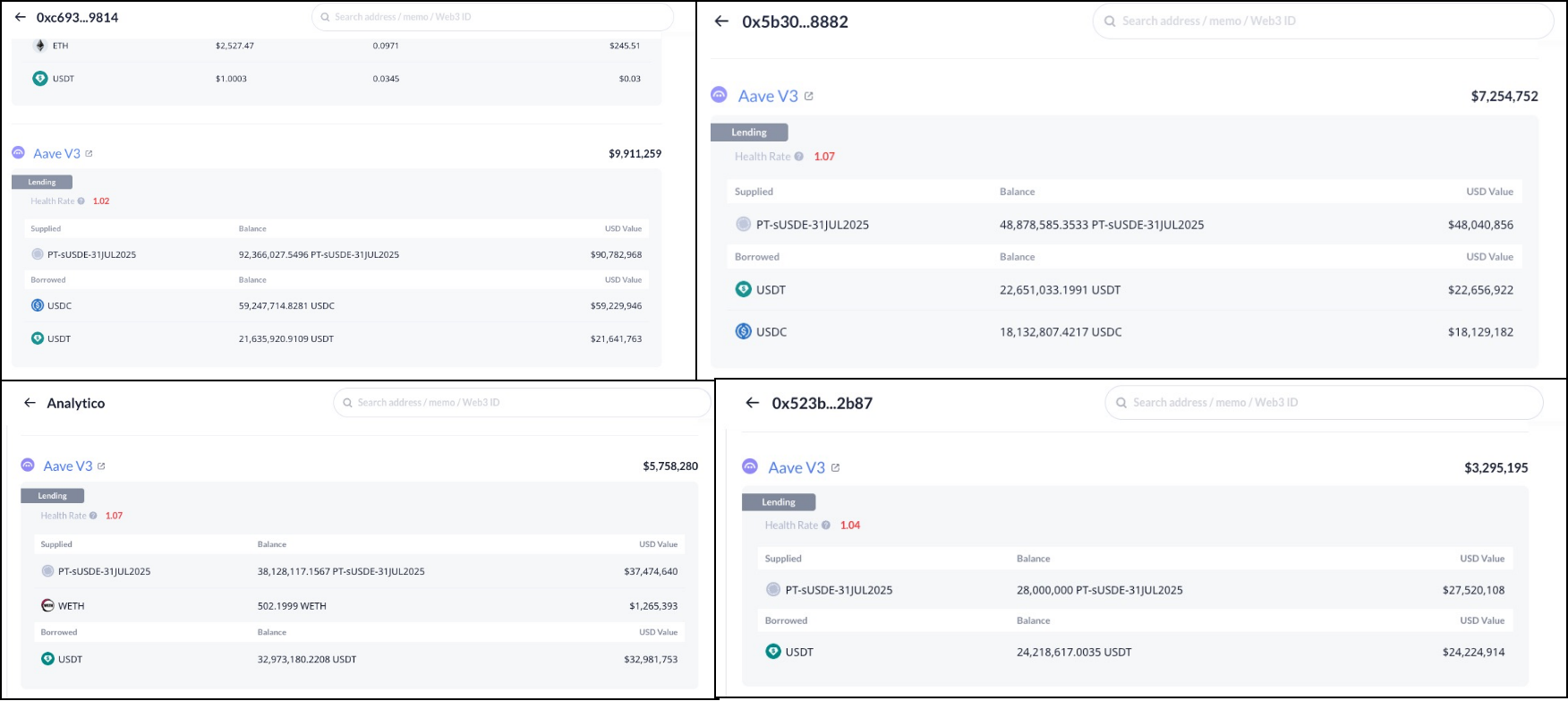 Therefore,
Therefore,
it can be seen that most investors are willing to allocate higher capital leverage for this strategy, but the author believes that the market may be a little too aggressive and optimistic, and this deviation of sentiment and risk perception will easily cause large-scale stampede liquidation, so let's analyze the risk of this strategy.
Thediscount rate risk cannot be ignored
,and the author sees that most DeFi analysis accounts will emphasize the low-risk nature of this strategy, and even advertise it as a risk-free arbitrage strategy. However, this is not the case, and we know that there are two main risks of leveraged mining strategies:
1. Exchange rate risk: When the exchange rate between the collateral and the borrowing target becomes smaller, there will be liquidation risk, which is easier to understand, because the collateral ratio will become lower in this process.
2. Interest rate risk: When the borrowing rate increases, the overall return of the strategy may be negative.
Most analysts will believe that the exchange rate risk of this strategy is extremely low, because as a more mature stablecoin protocol, USDe has experienced the test of the market, and its price de-anchoring risk is low, so as long as the borrowing target is a stablecoin type, the exchange rate risk is low, and even if de-anchoring occurs, as long as the borrowing target is USDe, the relative exchange rate will not drop significantly.
However, this judgment ignores the particularity of PT assets, and we know that the most critical function of the lending protocol is that it must be liquidated in a timely manner to avoid bad debts. However, there is a concept of duration for PT assets, and during the duration period, if you want to redeem the principal assets early, you can only trade at a discount through the AMM secondary market provided by Pendle. Therefore, the transaction will affect the price of the PT asset, or the PT yield, so the price of the PT asset is constantly changing with the trade, but the general direction will gradually approach 1.

Now that this feature is clear, let's take a look at AAVE's oracle design for PT asset prices. In fact, prior to AAVE's support for PT, the strategy primarily leveraged Morpho as a leveraged funding source, where the price oracle for PT assets was designed called PendleSparkLinearDiscountOracle. To put it simply, Morpho believes that during the duration of the bond, PT assets will receive income at a fixed interest rate relative to the native asset, ignoring the impact of market transactions on interest rates, which means that the conversion rate of PT assets relative to the primary asset is constantly increasing linearly. Therefore, it is natural to ignore the exchange rate risk.

However, in the process of researching the oracle scheme for PT assets, AAVE believes that this is not a good choice, because the scheme locks in the yield and is not adjustable during the duration of PT assets, which means that the model cannot actually reflect the impact of market transactions or changes in the underlying yield of PT assets on the price of PT, and if the market sentiment is bullish on interest rate changes in the short term, or there is a structural upward trend in the underlying yield (such as a sharp rise in the price of incentive tokens, a new income distribution scheme, etc.), which may cause the oracle price of PT assets in Morpho to be much higher than the real price, which can easily lead to bad debts. In order to reduce this risk, Morpho usually sets a benchmark interest rate that is much higher than the market interest rate, which means that Morpho will actively reduce the value of PT assets and set up a more ample room for volatility, which in turn will lead to the problem of low capital utilization.
In order to optimize this problem, AAVE adopts an off-chain pricing solution, which can enable the oracle price to follow the pace of structural changes in PT interest rates as much as possible, and avoid the risk of market manipulation in the short term. We will not discuss the technical details here, there is a special discussion on this issue in the AAVE forum, and interested partners can also discuss with the author in X. Here is just a look at the possible price following effect of PT Oracle in AAVE. It can be seen that in AAVE, Oracle's price performance will be similar to the piecewise function, which follows the market interest rate, which is more capital efficient than Morpho's linear pricing model, and also better mitigates the risk of bad debts.
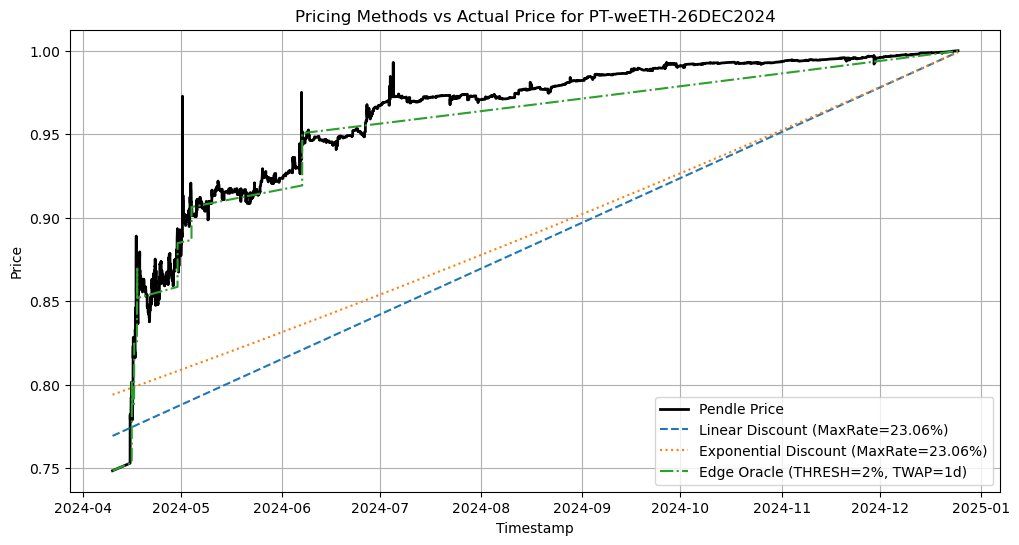
So this means that if there is a structural adjustment in the interest rate of PT assets, or when the market has a consistent direction for interest rate changes in the short term, AAVE Oracle will follow this change, so this introduces discount rate risk to the strategy, that is, assuming that the PT interest rate rises for some reason, the price of PT assets will fall accordingly, and the strategy's over-leveraged ratio may have liquidation risk. Therefore, we need to clarify AAVE Oracle's pricing mechanism for PT assets, so that we can rationally adjust leverage and effectively balance risk and return. Here are some of the key features for you to think about:
1. Since the mechanism of the Pendle AMM is designed, liquidity will be concentrated towards the current interest rate over time, which means that the price changes brought about by market transactions will become less and less obvious, and the slippage will become less and less. Therefore, the expiration date is approaching, and the price change caused by market behavior will be smaller and smaller, and for this feature, AAVE Oracle has set up the concept of heartbeat to indicate the frequency of price updates, the closer to the expiration date, the larger the hearbeat, the lower the update frequency, that is, the lower the discount rate risk.
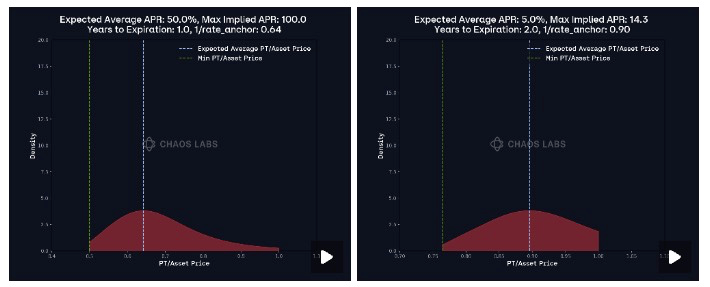
2. AAVE Oracle will follow a 1% interest rate change as another adjustment factor for price updates, triggering a price update when the market rate deviates from the Oracle rate by 1% and deviates more than hearbeat. Therefore, this mechanism also provides a time window to adjust the leverage ratio in time to avoid liquidation. Therefore, for users of this strategy, it is necessary to monitor interest rate changes as much as possible and adjust the leverage ratio mechanism.
